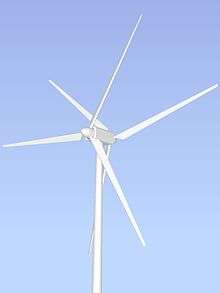Wind turbine
| Part of a series on |
| Renewable energy |
|---|
A wind turbine is a device that converts the wind's kinetic energy into electrical power.
Wind turbines are manufactured in a wide range of vertical and horizontal axis types. The smallest turbines are used for applications such as battery charging for auxiliary power for boats or caravans or to power traffic warning signs. Slightly larger turbines can be used for making contributions to a domestic power supply while selling unused power back to the utility supplier via the electrical grid. Arrays of large turbines, known as wind farms, are becoming an increasingly important source of intermittent renewable energy and are used by many countries as part of a strategy to reduce their reliance on fossil fuels.
History

Wind power was probaly used in Persia (present-day Iran) about 500–900 A.D.[1] The windwheel of Hero of Alexandria marks one of the first recorded instances of wind powering a machine in history.[2][3] However, the first known practical wind power plants were built in Sistan, an Eastern province of Iran, from the 7th century. These "Panemone" were vertical axle windmills, which had long vertical drive shafts with rectangular blades.[4] Made of six to twelve sails covered in reed matting or cloth material, these windmills were used to grind grain or draw up water, and were used in the gristmilling and sugarcane industries.[5]
Wind power first appeared in Europe during the Middle Ages. The first historical records of their use in England date to the 11th or 12th centuries and there are reports of German crusaders taking their windmill-making skills to Syria around 1190.[6] By the 14th century, Dutch windmills were in use to drain areas of the Rhine delta. Advanced wind mills were described by Croatian inventor Fausto Veranzio. In his book Machinae Novae (1595) he described vertical axis wind turbines with curved or V-shaped blades.
The first electricity-generating wind turbine was a battery charging machine installed in July 1887 by Scottish academic James Blyth to light his holiday home in Marykirk, Scotland.[7] Some months later American inventor Charles F. Brush was able to build the first automatically operated wind turbine after consulting local University professors and colleagues Jacob S. Gibbs and Brinsley Coleberd and successfully getting the blueprints peer-reviewed for electricity production in Cleveland, Ohio.[7] Although Blyth's turbine was considered uneconomical in the United Kingdom[7] electricity generation by wind turbines was more cost effective in countries with widely scattered populations.[6]

In Denmark by 1900, there were about 2500 windmills for mechanical loads such as pumps and mills, producing an estimated combined peak power of about 30 MW. The largest machines were on 24-meter (79 ft) towers with four-bladed 23-meter (75 ft) diameter rotors. By 1908 there were 72 wind-driven electric generators operating in the United States from 5 kW to 25 kW. Around the time of World War I, American windmill makers were producing 100,000 farm windmills each year, mostly for water-pumping.[9]
By the 1930s, wind generators for electricity were common on farms, mostly in the United States where distribution systems had not yet been installed. In this period, high-tensile steel was cheap, and the generators were placed atop prefabricated open steel lattice towers.
A forerunner of modern horizontal-axis wind generators was in service at Yalta, USSR in 1931. This was a 100 kW generator on a 30-meter (98 ft) tower, connected to the local 6.3 kV distribution system. It was reported to have an annual capacity factor of 32 percent, not much different from current wind machines.[10]
In the autumn of 1941, the first megawatt-class wind turbine was synchronized to a utility grid in Vermont. The Smith-Putnam wind turbine only ran for 1,100 hours before suffering a critical failure. The unit was not repaired, because of shortage of materials during the war.
The first utility grid-connected wind turbine to operate in the UK was built by John Brown & Company in 1951 in the Orkney Islands.[7][11]
Despite these diverse developments, developments in fossil fuel systems almost entirely eliminated any wind turbine systems larger than supermicro size. In the early 1970s, however, anti-nuclear protests in Denmark spurred artisan mechanics to develop microturbines of 22 kW. Organizing owners into associations and co-operatives lead to the lobbying of the government and utilities and provided incentives for larger turbines throughout the 1980s and later. Local activists in Germany, nascent turbine manufacturers in Spain, and large investors in the United States in the early 1990s then lobbied for policies that stimulated the industry in those countries. Later companies formed in India and China. As of 2012, Danish company Vestas is the world's biggest wind-turbine manufacturer.
Resources
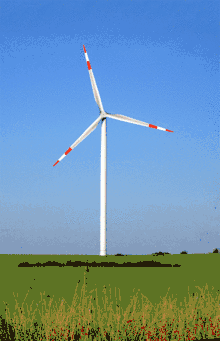
A quantitative measure of wind energy available at any location is called the Wind Power Density (WPD). It is a calculation of the mean annual power available per square meter of swept area of a turbine, and is tabulated for different heights above ground. Calculation of wind power density includes the effect of wind velocity and air density. Color-coded maps are prepared for a particular area described, for example, as "Mean Annual Power Density at 50 Metres". In the United States, the results of the above calculation are included in an index developed by the National Renewable Energy Laboratory and referred to as "NREL CLASS". The larger the WPD, the higher it is rated by class. Classes range from Class 1 (200 watts per square meter or less at 50 m altitude) to Class 7 (800 to 2000 watts per square m). Commercial wind farms generally are sited in Class 3 or higher areas, although isolated points in an otherwise Class 1 area may be practical to exploit.[12]
Wind turbines are classified by the wind speed they are designed for, from class I to class IV, with A or B referring to the turbulence.[13]
| Class | Avg Wind Speed (m/s) | Turbulence |
|---|---|---|
| IA | 10 | 18% |
| IB | 10 | 16% |
| IIA | 8.5 | 18% |
| IIB | 8.5 | 16% |
| IIIA | 7.5 | 18% |
| IIIB | 7.5 | 16% |
| IVA | 6 | 18% |
| IVB | 6 | 16% |
Efficiency
Not all the energy of blowing wind can be used, but some small wind turbines are designed to work at low wind speeds.[14]
Conservation of mass requires that the amount of air entering and exiting a turbine must be equal. Accordingly, Betz's law gives the maximal achievable extraction of wind power by a wind turbine as 16/27 (59.3%) of the total kinetic energy of the air flowing through the turbine.[15]
The maximum theoretical power output of a wind machine is thus 16/27 times the kinetic energy of the air passing through the effective disk area of the machine. If the effective area of the disk is A, and the wind velocity v, the maximum theoretical power output P is:
- ,
where ρ is the air density.
As wind is free (no fuel cost), wind-to-rotor efficiency (including rotor blade friction and drag) is one of many aspects impacting the final price of wind power.[16] Further inefficiencies, such as gearbox losses, generator and converter losses, reduce the power delivered by a wind turbine. To protect components from undue wear, extracted power is held constant above the rated operating speed as theoretical power increases at the cube of wind speed, further reducing theoretical efficiency. In 2001, commercial utility-connected turbines deliver 75% to 80% of the Betz limit of power extractable from the wind, at rated operating speed.[17][18]
Efficiency can decrease slightly over time due to wear. Analysis of 3128 wind turbines older than 10 years in Denmark showed that half of the turbines had no decrease, while the other half saw a production decrease of 1.2% per year.[19] Vertical turbine designs have much lower efficiency than standard horizontal designs.[20]
Types
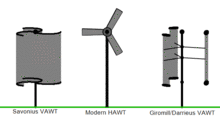
Wind turbines can rotate about either a horizontal or a vertical axis, the former being both older and more common.[21] They can also include blades (transparent or not)[22] or be bladeless.[23] Vertical designs produce less power and are less common.[24]
Horizontal axis


Horizontal-axis wind turbines (HAWT) have the main rotor shaft and electrical generator at the top of a tower, and must be pointed into the wind. Small turbines are pointed by a simple wind vane, while large turbines generally use a wind sensor coupled with a servo motor. Most have a gearbox, which turns the slow rotation of the blades into a quicker rotation that is more suitable to drive an electrical generator.[25]
Any solid object produces a wake behind it, leading to fatigue failures, so the turbine is usually positioned upwind of its supporting tower. Downwind machines have been built, because they don't need an additional mechanism for keeping them in line with the wind. In high winds, the blades can also be allowed to bend which reduces their swept area and thus their wind resistance. In upwind designs, turbine blades must be made stiff to prevent the blades from being pushed into the tower by high winds. Additionally, the blades are placed a considerable distance in front of the tower and are sometimes tilted forward into the wind a small amount.
Turbines used in wind farms for commercial production of electric power are usually three-bladed. These have low torque ripple, which contributes to good reliability. The blades are usually colored white for daytime visibility by aircraft and range in length from 20 to 80 meters (66 to 262 ft). The size and height of turbines increase year by year. Offshore wind turbines are built up to 8MW today and have a blade length up to 80m. Usual tubular steel towers of multi megawatt turbines have a height of 70 m to 120 m and in extremes up to 160 m.
The blades rotate at 10 to 22 revolutions per minute. At 22 rotations per minute the tip speed exceeds 90 meters per second (300 ft/s).[26][27] Higher tip speeds means more noise and blade erosion. A gear box is commonly used for stepping up the speed of the generator, although designs may also use direct drive of an annular generator. Some models operate at constant speed, but more energy can be collected by variable-speed turbines which use a solid-state power converter to interface to the transmission system. All turbines are equipped with protective features to avoid damage at high wind speeds, by feathering the blades into the wind which ceases their rotation, supplemented by brakes.
Vertical axis

Vertical-axis wind turbines (or VAWTs) have the main rotor shaft arranged vertically. One advantage of this arrangement is that the turbine does not need to be pointed into the wind to be effective, which is an advantage on a site where the wind direction is highly variable. It is also an advantage when the turbine is integrated into a building because it is inherently less steerable. Also, the generator and gearbox can be placed near the ground, using a direct drive from the rotor assembly to the ground-based gearbox, improving accessibility for maintenance. However, these designs produce much less energy averaged over time, which is a major drawback.[24][28]
The key disadvantages include the relatively low rotational speed with the consequential higher torque and hence higher cost of the drive train, the inherently lower power coefficient, the 360-degree rotation of the aerofoil within the wind flow during each cycle and hence the highly dynamic loading on the blade, the pulsating torque generated by some rotor designs on the drive train, and the difficulty of modelling the wind flow accurately and hence the challenges of analysing and designing the rotor prior to fabricating a prototype.[29]
When a turbine is mounted on a rooftop the building generally redirects wind over the roof and this can double the wind speed at the turbine. If the height of a rooftop mounted turbine tower is approximately 50% of the building height it is near the optimum for maximum wind energy and minimum wind turbulence. Wind speeds within the built environment are generally much lower than at exposed rural sites,[30][31] noise may be a concern and an existing structure may not adequately resist the additional stress.
Subtypes of the vertical axis design include:
.jpg)
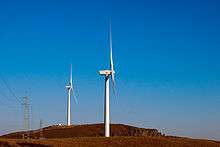
- Darrieus wind turbine
- "Eggbeater" turbines, or Darrieus turbines, were named after the French inventor, Georges Darrieus.[32] They have good efficiency, but produce large torque ripple and cyclical stress on the tower, which contributes to poor reliability. They also generally require some external power source, or an additional Savonius rotor to start turning, because the starting torque is very low. The torque ripple is reduced by using three or more blades which results in greater solidity of the rotor. Solidity is measured by blade area divided by the rotor area. Newer Darrieus type turbines are not held up by guy-wires but have an external superstructure connected to the top bearing.[33]
- Giromill
- A subtype of Darrieus turbine with straight, as opposed to curved, blades. The cycloturbine variety has variable pitch to reduce the torque pulsation and is self-starting.[34] The advantages of variable pitch are: high starting torque; a wide, relatively flat torque curve; a higher coefficient of performance; more efficient operation in turbulent winds; and a lower blade speed ratio which lowers blade bending stresses. Straight, V, or curved blades may be used.[35]
- Savonius wind turbine
- These are drag-type devices with two (or more) scoops that are used in anemometers, Flettner vents (commonly seen on bus and van roofs), and in some high-reliability low-efficiency power turbines. They are always self-starting if there are at least three scoops.
- Twisted Savonius
- Twisted Savonius is a modified savonius, with long helical scoops to provide smooth torque. This is often used as a rooftop windturbine and has even been adapted for ships.[36]
Another type of vertical axis is the Parallel turbine, which is similar to the crossflow fan or centrifugal fan. It uses the ground effect. Vertical axis turbines of this type have been tried for many years: a unit producing 10 kW was built by Israeli wind pioneer Bruce Brill in the 1980s.[37]
Floating wind turbines
In July 2017 work installing an experimental floating wind farm known as Hywind at Peterhead began. The turbines float on a sealed vase-like tube 78 metres deep which are filled with iron ore to weight the structures and keep them upright in the water. The wind farm is expected to supply power to 20,000 homes. Manufactured by Statoil, the floating turbines can be located in water up to a kilometre deep.[38]
Design and construction

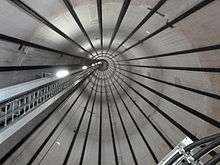
Wind turbines are designed, using a range of computer modelling techniques,[39] to exploit the wind energy that exists at a location. For example, Aerodynamic modeling is used to determine the optimum tower height, control systems, number of blades and blade shape.
Wind turbines convert wind energy to electricity for distribution. Conventional horizontal axis turbines can be divided into three components:
- The rotor component, which is approximately 20% of the wind turbine cost, includes the blades for converting wind energy to low speed rotational energy.
- The generator component, which is approximately 34% of the wind turbine cost, includes the electrical generator,[40][41] the control electronics, and most likely a gearbox (e.g. planetary gearbox),[42] adjustable-speed drive or continuously variable transmission[43] component for converting the low speed incoming rotation to high speed rotation suitable for generating electricity.
- The structural support component, which is approximately 15% of the wind turbine cost, includes the tower and rotor yaw mechanism.[44]
A 1.5 MW wind turbine of a type frequently seen in the United States has a tower 80 meters (260 ft) high. The rotor assembly (blades and hub) weighs 22,000 kilograms (48,000 lb). The nacelle, which contains the generator component, weighs 52,000 kilograms (115,000 lb). The concrete base for the tower is constructed using 26,000 kilograms (58,000 lb) of reinforcing steel and contains 190 cubic meters (250 cu yd) of concrete. The base is 15 meters (50 ft) in diameter and 2.4 meters (8 ft) thick near the center.[45]
Among all renewable energy systems wind turbines have the highest effective intensity of power-harvesting surface[46] because turbine blades not only harvest wind power, but also concentrate it.[47]
Unconventional designs
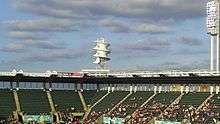
An E-66 wind turbine in the Windpark Holtriem, Germany, has an observation deck for visitors. Another turbine of the same type with an observation deck is located in Swaffham, England. Airborne wind turbine designs have been proposed and developed for many years but have yet to produce significant amounts of energy. In principle, wind turbines may also be used in conjunction with a large vertical solar updraft tower to extract the energy due to air heated by the sun.
Wind turbines which utilise the Magnus effect have been developed.[48]
A ram air turbine (RAT) is a special kind of small turbine that is fitted to some aircraft. When deployed, the RAT is spun by the airstream going past the aircraft and can provide power for the most essential systems if there is a loss of all on-board electrical power,[49] as in the case of the "Gimli Glider".
The two-bladed SCD 6MW offshore turbine designed by aerodyn Energiesysteme and built by MingYang Wind Power has a helideck for helicopters on top of its nacelle. The prototype was erected in 2014 in Rudong, China.
Turbine monitoring and diagnostics
Due to data transmission problems, structural health monitoring of wind turbines is usually performed using several accelerometers and strain gages attached to the nacelle to monitor the gearbox and equipments. Currently, digital image correlation and stereophotogrammetry are used to measure dynamics of wind turbine blades. These methods usually measure displacement and strain to identify location of defects. Dynamic characteristics of non-rotating wind turbines have been measured using digital image correlation and photogrammetry.[50] Three dimensional point tracking has also been used to measure rotating dynamics of wind turbines.[51]
Materials and durability
Materials that are typically used for the rotor blades in wind turbines are composites, as they tend to have a high stiffness, high strength, high fatigue resistance, and low weight.[52] Typical resins used for these composites include polyester and epoxy, while glass and carbon fibers have been used for the reinforcing material.[53] Construction may use manual layup techniques or composite resin injection molding. As the price of glass fibers is only about one tenth the price of carbon fiber, glass fiber is still dominant.
As competition in the wind market increases, companies are seeking ways to draw greater efficiency from their designs. One of the predominant ways wind turbines have gained performance is by increasing rotor diameters, and thus blade length. Retrofitting current turbines with larger blades mitigates the need and risks associated with a system-level redesign. By incorporating carbon fiber into parts of existing blade systems, manufacturers may increase the length of the blades without increasing their overall weight. For instance, the spar cap, a structural element of a turbine blade, commonly experiences high tensile loading, making it an ideal candidate to utilize the enhanced tensile properties of carbon fiber in comparison to glass fiber.[54] Higher stiffness and lower density translates to thinner, lighter blades offering equivalent performance. In a 10-MW turbine—which will become more common in offshore systems by 2021—blade lengths may reach over 100 m and weigh up to 50 metric tons when fabricated out of glass fiber. A switch to carbon fiber in the structural spar of the blade yields weight savings of 20 to 30 percent, or approximately 15 metric tons.[55] The compressive properties of carbon fiber do not differ significantly from those of glass fiber. It is therefore economical to replace glass fiber components under compression with carbon fiber components.
While the material cost is significantly higher for all-glass fiber blades than for hybrid glass/carbon fiber blades, there is a potential for tremendous savings in manufacturing costs when labor price is considered. Utilizing carbon fiber enables for simpler designs that use less raw material. The chief manufacturing process in blade fabrication is the layering of plies. By reducing the number of layers of plies, as is enabled by thinner blade design, the cost of labor may be decreased, and in some cases, equate to the cost of labor for glass fiber blades.[56]
Materials for wind turbine parts other than the rotor blades (including the rotor hub, gearbox, frame, and tower) are largely composed of steel. Modern turbines uses a couple of tonnes of copper for generators, cables and such.[57] Smaller wind turbines have begun incorporating more aluminum based alloys into these components in an effort to make the turbines more lightweight and efficient, and may continue to be used increasingly if fatigue and strength properties can be improved. Prestressed concrete has been increasingly used for the material of the tower, but still, requires much reinforcing steel to meet the strength requirement of the turbine. Additionally, step-up gearboxes are being increasingly replaced with variable speed generators, increasing the demand for magnetic materials in wind turbines.,[52] In particular, this would require an increased supply of the rare earth metal neodymium. Reliance on rare earth minerals for components has risked expense and price volatility as China has been main producer of rare earth minerals (96% in 2009) and had been reducing its export quotas of these materials.[58] In recent years, however, other producers have increased production of rare earth minerals and China has removed its reduced export quota on rare earths leading to an increased supply and decreased cost of rare earth minerals, increasing the viability of the implementation of variable speed generators in wind turbines on a large scale.[59]
Wind turbines on public display
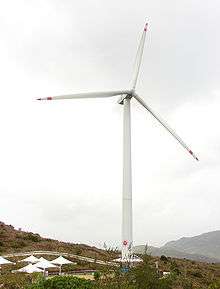
A few localities have exploited the attention-getting nature of wind turbines by placing them on public display, either with visitor centers around their bases, or with viewing areas farther away.[60] The wind turbines are generally of conventional horizontal-axis, three-bladed design, and generate power to feed electrical grids, but they also serve the unconventional roles of technology demonstration, public relations, and education.
Small wind turbines

Small wind turbines may be used for a variety of applications including on- or off-grid residences, telecom towers, offshore platforms, rural schools and clinics, remote monitoring and other purposes that require energy where there is no electric grid, or where the grid is unstable. Small wind turbines may be as small as a fifty-watt generator for boat or caravan use. Hybrid solar and wind powered units are increasingly being used for traffic signage, particularly in rural locations, as they avoid the need to lay long cables from the nearest mains connection point.[61] The U.S. Department of Energy's National Renewable Energy Laboratory (NREL) defines small wind turbines as those smaller than or equal to 100 kilowatts.[62] Small units often have direct drive generators, direct current output, aeroelastic blades, lifetime bearings and use a vane to point into the wind.
Larger, more costly turbines generally have geared power trains, alternating current output, flaps and are actively pointed into the wind. Direct drive generators and aeroelastic blades for large wind turbines are being researched.
Wind turbine spacing
On most horizontal windturbine farms, a spacing of about 6–10 times the rotor diameter is often upheld. However, for large wind farms distances of about 15 rotor diameters should be more economically optimal, taking into account typical wind turbine and land costs. This conclusion has been reached by research[63] conducted by Charles Meneveau of the Johns Hopkins University,[64] and Johan Meyers of Leuven University in Belgium, based on computer simulations[65] that take into account the detailed interactions among wind turbines (wakes) as well as with the entire turbulent atmospheric boundary layer. Moreover, recent research by John Dabiri of Caltech suggests that vertical wind turbines may be placed much more closely together so long as an alternating pattern of rotation is created allowing blades of neighbouring turbines to move in the same direction as they approach one another.[66]
Operability
Maintenance
Wind turbines need regular maintenance to stay reliable and available, reaching 98%.[67][68]
Modern turbines usually have a small onboard crane for hoisting maintenance tools and minor components. However, large heavy components like generator, gearbox, blades and so on are rarely replaced and a heavy lift external crane is needed in those cases. If the turbine has a difficult access road, a containerized crane can be lifted up by the internal crane to provide heavier lifting.[69]
Repowering
Installation of new wind turbines can be controversial. An alternative is repowering, where existing wind turbines are replaced with bigger, more powerful ones, sometimes in smaller numbers while keeping or increasing capacity.
Demolition
Older turbines were in some early cases not required to be removed when reaching the end of their life. Some still stand, waiting to be recycled or repowered.[70][71]
A demolition industry develops to recycle offshore turbines at a cost of DKK 2–4 million per MW, to be guaranteed by the owner.[72]
Advantages and Disadvantages
Advantages
Wind turbines are generally inexpensive. They will cost between two and six cents per kilowatt hour, which is one of the lowest-priced renewable energy sources in today's world.[73] And as technology needed for wind turbines continues to improve, the prices will decrease as well. In addition, there is no competitive market for wind energy, as it does not cost money to get ahold of wind.[73] The main cost of wind turbines are the installation process. The average cost is between $48,000 and $65,000 to install. However, the energy harvested from the turbine will offset the installation cost, as well as provide virtually free energy for years after.[74]
Wind turbines provide a clean energy source, emitting no greenhouse gases and no waste product. Over 1,500 tons of carbon dioxide per year can be eliminated by using a one megawatt turbine instead of one megawatt of energy from a fossil fuel.[75] Being environmentally friendly and green is a large advantage of wind turbines.
Wind turbines are also quite efficient. Wind farms can generate between 17 and 39 times as much power as they consume, and in the United States alone, wind turbines have produced about 16 billion kilowatt-hours of energy per year.[75]
Disadvantages
Wind turbines can be very large, reaching over 400 feet tall and with blades 50 yards long, and people have often complained about their visual impact.
Environmental impact of wind power includes effect on wildlife. Thousands of birds, including rare species, have been killed by the blades of wind turbines[76], though wind turbines contribute a relatively insignificantly to anthropogenic avian mortality. For every bird killed by a wind turbine in the US, nearly 500,000 are killed by each of feral cats and buildings [77]
Energy harnessed by wind turbines is intermittent, and is not a "dispatchable" source of power; it's availability is based on whether the wind is blowing, not whether electricity is needed. Turbines can be placed on ridges or bluffs to maximize the access of wind they have, but this also limits the locations where they can be placed.[73] In this way, wind energy is not a particularly reliable source of energy.
Records

- Largest capacity conventional drive
- The Vestas V164 has a rated capacity of 8 MW,[78] later upgraded to 9 MW.[79] The windmill has an overall height of 220 m (722 ft), a diameter of 164 m (538 ft), is for offshore use, and is the world's largest-capacity wind turbine since its introduction in 2014. The conventional drive train consist of a main gearbox and a medium speed PM generator. Prototype installed in 2014 at the National Test Center Denmark nearby Østerild. Series production began end of 2015.
- Largest capacity direct drive
- The Enercon E-126 with 7.58 MW and 127 m rotor diameter is the largest direct drive turbine. It's only for onshore use. The turbine has parted rotor blades with 2 sections for transport. In July 2016, Siemens upgraded its 7 to 8 MW.[80]
- Largest vertical-axis
- Le Nordais wind farm in Cap-Chat, Quebec has a vertical axis wind turbine (VAWT) named Éole, which is the world's largest at 110 m.[81] It has a nameplate capacity of 3.8 MW.[82]
- Largest 1-bladed turbine
- Riva Calzoni M33 was a single-bladed wind turbine with 350 kW, designed and built In Bologna in 1993.
- Largest 2-bladed turbine
- The biggest 2-bladed turbine is built by Mingyang Wind Power in 2013. It is a SCD6.5MW offshore downwind turbine, designed by aerodyn Energiesysteme.[83][84][85]
- Largest swept area
- The turbine with the largest swept area is the Samsung S7.0–171, with a diameter of 171 m, giving a total sweep of 22966 m2.
- Tallest
- A Nordex 3.3 MW was installed in July 2016. It has a total height of 230m, and a hub height of 164m on 100m concrete tower bottom with steel tubes on top (hybrid tower).[86]
- Vestas V164 was the tallest wind turbine, standing in Østerild, Denmark, 220 meters tall, constructed in 2014. It has a steel tube tower.
- Highest tower
- Fuhrländer installed a 2.5MW turbine on a 160m lattice tower in 2003 (see Fuhrländer Wind Turbine Laasow and Nowy Tomyśl Wind Turbines).
- Most rotors
- Lagerwey has build Four-in-One, a multi rotor wind turbine with one tower and four rotors near Maasvlakte. In April 2016, Vestas installed a 900 kW quadrotor test wind turbine at Risø, made from 4 recycled 225 kW V29 turbines.[87][88][89]
- Most productive
- Four turbines at Rønland Offshore Wind Farm in Denmark share the record for the most productive wind turbines, with each having generated 63.2 GWh by June 2010.[90]
- Highest-situated
- Since 2013 the world's highest-situated wind turbine was made and installed by WindAid and is located at the base of the Pastoruri Glacier in Peru at 4,877 meters (16,001 ft) above sea level.[91] The site uses the WindAid 2.5 kW wind generator to supply power to a small rural community of micro entrepreneurs who cater to the tourists who come to the Pastoruri glacier.[92]
- Largest floating wind turbine
- The world's largest—and also the first operational deep-water large-capacity—floating wind turbine is the 2.3 MW Hywind currently operating 10 kilometers (6.2 mi) offshore in 220-meter-deep water, southwest of Karmøy, Norway. The turbine began operating in September 2009 and utilizes a Siemens 2.3 MW turbine.[93][94]
See also
References
- ↑ "Part 1 – Early History Through 1875". Retrieved 31 July 2008.
- ↑ A.G. Drachmann, "Heron's Windmill", Centaurus, 7 (1961), pp. 145–151
- ↑ Dietrich Lohrmann, "Von der östlichen zur westlichen Windmühle", Archiv für Kulturgeschichte, Vol. 77, Issue 1 (1995), pp. 1–30 (10f.)
- ↑ Ahmad Y Hassan, Donald Routledge Hill (1986). Islamic Technology: An illustrated history, p. 54. Cambridge University Press. ISBN 0-521-42239-6.
- ↑ Donald Routledge Hill, "Mechanical Engineering in the Medieval Near East", Scientific American, May 1991, p. 64-69. (cf. Donald Routledge Hill, Mechanical Engineering)
- 1 2 Morthorst, Poul Erik; Redlinger, Robert Y.; Andersen, Per (2002). Wind energy in the 21st century: economics, policy, technology and the changing electricity industry. Houndmills, Basingstoke, Hampshire: Palgrave/UNEP. ISBN 0-333-79248-3.
- 1 2 3 4 Price, Trevor J. (2004). "Blyth, James (1839–1906)". Oxford Dictionary of National Biography (online ed.). Oxford University Press. doi:10.1093/ref:odnb/100957. (Subscription or UK public library membership required.)
- ↑ A Wind Energy Pioneer: Charles F. Brush. Danish Wind Industry Association. Retrieved 28 December 2008.
- ↑ Quirky old-style contraptions make water from wind on the mesas of West Texas Archived 3 February 2008 at the Wayback Machine.
- ↑ Alan Wyatt: Electric Power: Challenges and Choices. Book Press Ltd., Toronto 1986, ISBN 0-920650-00-7
- ↑ Anon. "Costa Head Experimental Wind Turbine". Orkney Sustainable Energy Website. Orkney Sustainable Energy Ltd. Retrieved 19 December 2010.
- ↑ "NREL: Dynamic Maps, GIS Data, and Analysis Tools – Wind Maps". Nrel.gov. 3 September 2013. Retrieved 6 November 2013.
- ↑ IEC Wind Turbine Classes 7 June 2006
- ↑ Small-Scale "Dragonfly" Wind Turbine Works at Low Wind Speeds
- ↑ "The Physics of Wind Turbines Kira Grogg Carleton College, 2005, p.8" (PDF). Retrieved 6 November 2013.
- ↑ "Wind Energy Basics". Bureau of Land Management. Retrieved 23 April 2016.
- ↑ "Enercon E-family, 330 Kw to 7.5 Mw, Wind Turbine Specification" Archived 16 May 2011 at the Wayback Machine.
- ↑ Tony Burton et al., (ed), Wind Energy Handbook, John Wiley and Sons 2001 ISBN 0471489972 page 65
- ↑ Sanne Wittrup. "11 years of wind data shows surprising production decrease" (in Danish) Ingeniøren, 1 November 2013. Retrieved 2 November 2013.
- ↑ E. Hau., Wind Turbines: Fundamentals, Technologies, Application, Economics. Springer. Germany. 2006
- ↑ "Wind Energy Basics". American Wind Energy Association. Archived from the original on 23 September 2010. Retrieved 24 September 2009.
- ↑ Transparent plexiglass blades
- ↑ No blades
- 1 2 http://www.wind-works.org/cms/index.php?id=64&tx_ttnews%5Btt_news%5D=3103&cHash=be80a2ca690fe1bcec1c0dc0af1e795b
- ↑ Archived 7 June 2008 at the Wayback Machine.
- ↑ "Products & Services". Gepower.com. Retrieved 6 November 2013.
- ↑ "Technical Specs of Common Wind Turbine Models". Aweo.org.
- ↑ http://cleantechnica.com/2014/04/07/vertical-axis-wind-turbines-great-1890-also-rans-2014/
- ↑ http://www.awsopenwind.org/downloads/documentation/ModelingUncertaintyPublic.pdf
- ↑ Hugh Piggott (6 January 2007). "Windspeed in the city – reality versus the DTI database". Scoraigwind.com. Retrieved 6 November 2013.
- ↑ http://www.urbanwind.net/pdf/technological_analysis.pdf
- ↑ "Vertical-Axis Wind Turbines". Symscape. 7 July 2008. Retrieved 6 November 2013.
- ↑ Exploit Nature-Renewable Energy Technologies by Gurmit Singh, Aditya Books, pp 378
- ↑ Archived 3 April 2005 at the Wayback Machine.
- ↑ "Experimental Mechanics, Volume 18, Number 1 – SpringerLink" (PDF). Springerlink.com. 1 January 1978. Retrieved 6 November 2013.
- ↑ Rob Varnon. Derecktor converting boat into hybrid passenger ferry, Connecticut Post website, 2 December 2010. Retrieved 25 April 2012.
- ↑ "Modular wind energy device – Brill, Bruce I". Freepatentsonline.com. 19 November 2002. Retrieved 6 November 2013.
- ↑ Harrabin, Roger (2017-07-23). "World's first floating wind farm emerges off coast of Scotland". BBC News. Retrieved 2017-07-23.
- ↑ Hewitt, Sam; Margetts, Lee & Revell, Alistair (18 April 2017). "Building a digital wind farm". Archives of Computational Methods in Engineering. Retrieved 20 April 2017.
- ↑ Navid Goudarzi (June 2013). "A Review on the Development of the Wind Turbine Generators across the World". International Journal of Dynamics and Control. Springer. 1 (2): 192–202. doi:10.1007/s40435-013-0016-y.
- ↑ Navid Goudarzi; Weidong Zhu (November 2012). "A Review of the Development of Wind Turbine Generators Across the World". ASME 2012 International Mechanical Engineering Congress and Exposition. ASME. 4 – Paper No: IMECE2012-88615: 1257–1265.
- ↑ "Hansen W4 series". Hansentransmissions.com. Archived from the original on 15 March 2012. Retrieved 6 November 2013.
- ↑ John Gardner, Nathaniel Haro & Todd Haynes (October 2011). "Active Drivetrain Control to Improve Energy Capture of Wind Turbines" (PDF). Boise State University. Retrieved 28 February 2012
- ↑ ""Wind Turbine Design Cost and Scaling Model", Technical Report NREL/TP-500-40566, December, 2006, page 35, 36" (PDF). Retrieved 6 November 2013.
- ↑ Archived 15 July 2011 at the Wayback Machine.
- ↑ See Erich Hau: Windkraftanlagen: Grundlagen, Technik, Einsatz, Wirtschaftlichkeit. Berlin/ Heidelberg 2008, pp. 621. (German). (For the english Edition see Erich Hau, Wind Turbines: Fundamentals, Technologies, Application, Economics, Springer 2005)
- ↑ "Innovation in Wind Turbine Design" (2011), Peter Jamieson
- ↑ "Spiral Magnus|MECARO|Introducuction to Magnus". Mecaro.jp. Retrieved 6 November 2013.
- ↑ "Ram Air Turbine Electrical Systems". UTC Aerospace Systems. UTC Aerospace Systems. 2016.
- ↑ Using Stereophotogrammetry to Predict Dynamic Strain on A Wind Turbine Rotor
- ↑ Using Stereophotogrammetry to Measure Vibrations of a Rotating Wind Turbine
- 1 2 Ancona, Dan; Jim, McVeigh. "Wind Turbine – Materials and Manufacturing Fact Sheet". psu.edu. Retrieved 6 November 2016.
- ↑ Watson, James; Serrano, Juan. "Composite Materials for Wind Blades". windsystemsmag.com. Retrieved 6 November 2016.
- ↑ Davis, imphatic Labs, Garrett. "Composite Materials for Wind Blades – Wind Systems Magazine". www.windsystemsmag.com. Retrieved 12 November 2016.
- ↑ "Wind turbine blades: Glass vs. carbon fiber". www.compositesworld.com. Retrieved 12 November 2016.
- ↑ Ong & Tsai, Cheng-Huat & Stephen W. (2000). "The Use of Carbon Fibers in Wind Turbine Blade Design" (PDF). http://energy.sandia.gov/. External link in
|website=(help) - ↑ Frost and Sullivan, 2009, cited in Wind Generator Technology, by Eclareon S.L., Madrid, May 2012; www.eclareon.com; Available at Leonardo Energy – Ask an Expert; http://www.leonardo-energy.org/ask-expert
- ↑ Wilburn, David. "Wind Energy in the United States and Materials Required for the Land-Based Wind Turbine Industry From 2010 Through 2030" (PDF). U.S. Department of the Interior.
- ↑ Yap, Chui-Wei. "China Ends Rare-Earth Minerals Export Quotas". wsg.com.
- ↑ Young, Kathryn (3 August 2007). "Canada wind farms blow away turbine tourists". Edmonton Journal. Retrieved 6 September 2008.
- ↑ Anon. "Solar & Wind Powered Sign Lighting". Energy Development Cooperative Ltd. Retrieved 19 October 2013.
- ↑ Small Wind, U.S. Department of Energy National Renewable Energy Laboratory website
- ↑ J. Meyers and C. Meneveau, "Optimal turbine spacing in fully developed wind farm boundary layers" (2012), Wind Energy 15, 305–317 doi:10.1002/we.469
- ↑ Print version (18 January 2011). "Optimal spacing for wind turbines". Gazette.jhu.edu. Retrieved 6 November 2013.
- ↑ "M. Calaf, C. Meneveau and J. Meyers, "Large Eddy Simulation study of fully developed wind-turbine array boundary layers" (2010), Phys. Fluids 22, 015110". Link.aip.org. Retrieved 6 November 2013.
- ↑ Dabiri, J. Potential order-of-magnitude enhancement of wind farm power density via counter-rotating vertical-axis wind turbine arrays (2011), J. Renewable Sustainable Energy 3, 043104
- ↑ G.J.W. van Bussel, PhD; M.B. Zaaijer, MSc Reliability, Availability and Maintenance aspects of large-scale offshore wind farms page 2 Delft University of Technology, 2001.
- ↑ "Iberwind builds on 98% availability with fresh yaw, blade gains". 15 February 2016. Retrieved 30 May 2016.
- ↑ Morten Lund (30 May 2016). "Dansk firma sætter prisbelønnet selvhejsende kran i serieproduktion". Ingeniøren. Retrieved 30 May 2016.
- ↑ Jeremy Fugleberg (8 May 2014). "Abandoned Dreams of Wind and Light". Atlas Obscura. Retrieved 30 May 2016.
- ↑ Tom Gray (11 March 2013). "Fact check: About those 'abandoned' turbines ...". American Wind Energy Association. Retrieved 30 May 2016.
- ↑ "Aldrende havmølleparker åbner marked for klog nedrivning". Ingeniøren. Retrieved 20 May 2016.
- 1 2 3 "Advantages and Disadvantages of Wind Energy - Clean Energy Ideas". Clean Energy Ideas. 2013-06-19. Retrieved 2017-05-10.
- ↑ "Residential Wind Energy Systems - Bergey Wind PowerBergey Wind Power". bergey.com. Retrieved 2017-05-10.
- 1 2 "About Wind Energy: Factsheets and Statistics". www.pawindenergynow.org. Retrieved 2017-05-10.
- ↑ Hosansky, David (April 1, 2011). "Wind Power: Is wind energy good for the environment?". CQ Researcher.
- ↑ Sovacool, B. K. (2013). The avian benefits of wind energy: A 2009 update. Renewable Energy, 49, 19-24.
- ↑ Wittrup, Sanne. "Power from Vestas' giant turbine" (in Danish. English translation ). Ingeniøren, 28 January 2014. Retrieved 28 January 2014.
- ↑ http://www.mhivestasoffshore.com: "", retrieved 19 June 2017.
- ↑ http://www.windpowermonthly.com/article/1401293/siemens-confirms-8mw-turbine
- ↑ "Visits : Big wind turbine". Retrieved 17 April 2010.
- ↑ "Wind Energy Power Plants in Canada – other provinces". 5 June 2010. Retrieved 24 August 2010.
- ↑ http://www.windpoweroffshore.com/article/1207686/close---aerodyns-6mw-offshore-turbine-design
- ↑ http://www.windpowermonthly.com/article/1188373/ming-yang-install-65mw-offshore-turbine
- ↑ David Weston. "Aerodyn 6MW connected to grid" 12 March 2015. Archive
- ↑ http://www.windpowermonthly.com/article/1400374/nordex-installs-230-metre-onshore-turbine
- ↑ "EXCLUSIVE: Vestas tests four-rotor concept turbine". Windpower Monthly. Retrieved 20 April 2016.
- ↑ Sanne Wittrup. "Vestas rejser usædvanlig ny multirotor-vindmølle". Ingeniøren. Retrieved 20 April 2016.
- ↑ Video of quadrotor on YouTube
- ↑ "Surpassing Matilda: record-breaking Danish wind turbines". Retrieved 26 July 2010.
- ↑ http://www.guinnessworldrecords.com/world-records/highest-altitude-wind-generator
- ↑ http://www.lehighvalleylive.com/bethlehem/index.ssf/2013/08/northampton_community_college_53.html
- ↑ Patel, Prachi (22 June 2009). "Floating Wind Turbines to Be Tested". IEEE Spectrum. Retrieved 7 March 2011.
will test how the 2.3-megawatt turbine holds up in 220-meter-deep water.
- ↑ Madslien, Jorn (8 September 2009). "Floating challenge for offshore wind turbine". BBC News. Retrieved 7 March 2011.
world's first full-scale floating wind turbine
Further reading
- Tony Burton, David Sharpe, Nick Jenkins, Ervin Bossanyi: Wind Energy Handbook, John Wiley & Sons, 2nd edition (2011), ISBN 978-0-470-69975-1
- Darrell, Dodge, Early History Through 1875, TeloNet Web Development, Copyright 1996–2001
- Ersen Erdem, Wind Turbine Industrial Applications
- Robert Gasch, Jochen Twele (ed.), Wind power plants. Fundamentals, design, construction and operation, Springer 2012 ISBN 978-3-642-22937-4.
- Erich Hau, Wind turbines: fundamentals, technologies, application, economics Springer, 2013 ISBN 978-3-642-27150-2 (preview on Google Books)
- Siegfried Heier, Grid integration of wind energy conversion systems John Wiley & Sons, 3rd edition (2014), ISBN 978-1-119-96294-6
- Peter Jamieson, Innovation in Wind Turbine Design. Wiley & Sons 2011, ISBN 978-0-470-69981-2
- J. F. Manwell, J. G. McGowan, A. L. Roberts, Wind Energy Explained: Theory, Design and Application, John Wiley & Sons, 2nd edition (2012), ISBN 978-0-47001-500-1
- David Spera (ed,) Wind Turbine Technology: Fundamental Concepts in Wind Turbine Engineering, Second Edition (2009), ASME Press, ISBN 9780791802601
- Alois Schaffarczyk (ed.), Understanding wind power technology, John Wiley & Sons, (2014), ISBN 978-1-118-64751-6
- Hermann-Josef Wagner, Jyotirmay Mathur, Introduction to wind energy systems. Basics, technology and operation. Springer (2013), ISBN 978-3-642-32975-3
- GA Mansoori, N Enayati, LB Agyarko (2016), Energy: Sources, Utilization, Legislation, Sustainability, Illinois as Model State
External links
| Wikimedia Commons has media related to Wind turbine. |
- Harvesting the Wind (45 lectures about wind turbines by professor Magdi Ragheb
- Wind Projects
- Make small wind turbine at home Complete video and image Guide by Newphysicist
- Guided tour on wind energy
- U.S. Wind Turbine Manufacturing: Federal Support for an Emerging Industry Congressional Research Service
- Wind Energy Technology World Wind Energy Association
- Wind turbine simulation, National Geographic
- Airborne Wind Industry Association international
- Top 10 biggest wind turbines in the world
- The Tethys database seeks to gather, organize and make available information on potential environmental effects of offshore wind energy development
- Wind Turbine production. How It's Made. 2013.
.jpg)
